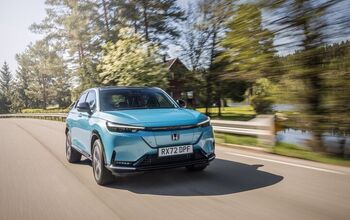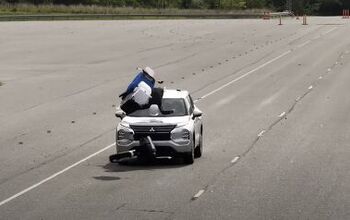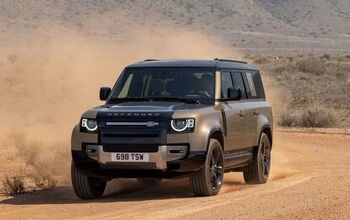Honda Speaks About Near Future, EV Plans

Honda has sent us a brief on its hopes and plans for the near future.
Not surprisingly, there's a fair amount of optimism and some gestures toward EV plans.
Of course, corporations are going to put their best foot forward in these types of media briefs, so you can take things with a grain of salt (or maybe Jimmy Buffett's lost shaker), but here are the highlights:
- As of the end of the 2023 fiscal year that ended on March 31, Honda has cut fixed costs by more than 10 percent since fiscal year 2019. The company also says its break-even point based on the percentage of production capacity being utilized is down about 10 percent, again since fiscal year 2019. Honda also says it's continuing to aim to reach a goal of a 7 percent return on sales by fiscal year 2026.
- Honda is touting increased relationships with semiconductor manufacturers, including Taiwan Semiconductor Manufacturing Company Limited.
- Like many OEMs, Honda has ambitious EV goals -- goals we've generally been skeptical about. In this case, Honda wants to be 100 percent EV and fuel-cell EV by 2040. To that end, the company is making vague promises about working on procuring and developing batteries, as well as procuring materials for battery-making from recyclers.
- Honda has plans for a mid- to large-size electric vehicle to debut for sale in North America in 2025, based on a dedicated platform. An EV based on the N-ONE will go on sale in Japan in 2025, with two small EVs following in 2026. One will be an SUV.
- The company has a focus on software and plans to double the number of hires already planned and will add an executive to be in charge of user experience.
- Finally, the company is sinking 100 billion yen into the research of "next-generation mobility." The company doesn't say what that is, but we suspect autonomous vehicles are involved somehow.
There's more. Honda is focusing on zero traffic collision fatalities and zero environmental impact, and it plans to aim to accomplish those goals via carbon neutrality, using vehicles as an energy source, circulating resources, automated driving and advanced driver-assist systems, and the connected Internet of things.
It's not just electric cars the company has set its sights on. Honda claims to be launching 10 electric motorcycles globally by 2025. The ultimate goal is electric motorcycle sales of 3.5 million units, or 15 percent of overall sales, by 2030. That includes the launch of the EM1e, an electric scooter with a swappable battery, in Indonesia, Europe, and Japan before the end of this year.
Swappable batteries aren't the only approach -- the company is researching other power sources for electric motorcycles.
Back to cars: Honda is going to launch the e:NS2 and e:NP2 EVs in China early next year, along with models based on the e:N SUV xu concept that will launch later in the year. Overall, the company is aiming for 10 new EVs in the Chinese market by 2027, with 100 percent electrification by 2035.
The North American market will see the Honda Prologue and Acura ZDX launch in 2024 next year, along with the aforementioned EV on a dedicated platform. Japan will also get a mini-EV based on the N-VAN for commercial use in the first half of next year.
Honda is planning to dive deeper into the charging business too, using the power supply provided by EVs. There will also be some sort of partnership with an existing company that does public charging so that Honda can better provide public charging options to its EV customers.
Honda is, as we know, working with GM on Ultium batteries for the North American market, and it's working with suppliers Contemporary Amperex Technology Co., Limited in China and Envision AESC in Japan.
That's for the short term -- Honda will work on creating semi-solid-state and all-solid-state batteries in-house further down the road. It's also going to work with GS Yuasa International on high-capacity, high-output liquid lithium-ion batteries. Honda is projecting that it will be bringing all-solid-state batteries to the market by the second half of this decade.
The company will work with SES AI Corporation on semi-solid-state batteries.
Honda is going to work with Hanwa Co., Ltd on procuring materials such as nickel, cobalt, and lithium. The recyclers Honda will work with for materials include Ascend Elements, Inc., Cirba Solutions, and POSCO Holdings, Inc.
EVs will be built right here in the States, with the Marysville and East Liberty plants in Ohio being retooled along with the Anna Engine plant, which is also in Ohio.
Speaking of plants, Honda claims that the Saitama plant in Japan will be carbon neutral by the end of fiscal year 2026. In addition to reducing carbon emissions from its plants, the company is going to use automation and artificial intelligence as part of its plans to both adjust to how the future workforce changes, and to be able to shift to building EVs quickly.
Finally, you might see a new Honda tagline -- "How We Move You" -- working with "Create, Transcend, Augment" and the current "Power of Dreams" slogan.
That's a lot, and I spent a lot of time translating corpo-speak while writing this post. We are skeptical of most automaker's timelines when it comes to full electrification, for a lot of reasons (tech developing slower than planned, infrastructure issues, some remaining demand for ICEs (maybe in limited applications like sports cars), an ever-shifting regulatory environment, and more). So we're skeptical here, too. That doesn't mean we're cynical --Honda and other automakers certainly could hit their targets -- just that it won't be easy.
That said, Honda has laid out its strategy for electrification and other key aspects of its business for the next few years. Your author won't predict here if the company will be successful or not, but the company does at least have a fairly clear road map forward.
[Image: Honda]
Become a TTAC insider. Get the latest news, features, TTAC takes, and everything else that gets to the truth about cars first by subscribing to our newsletter.

Tim Healey grew up around the auto-parts business and has always had a love for cars — his parents joke his first word was “‘Vette”. Despite this, he wanted to pursue a career in sports writing but he ended up falling semi-accidentally into the automotive-journalism industry, first at Consumer Guide Automotive and later at Web2Carz.com. He also worked as an industry analyst at Mintel Group and freelanced for About.com, CarFax, Vehix.com, High Gear Media, Torque News, FutureCar.com, Cars.com, among others, and of course Vertical Scope sites such as AutoGuide.com, Off-Road.com, and HybridCars.com. He’s an urbanite and as such, doesn’t need a daily driver, but if he had one, it would be compact, sporty, and have a manual transmission.
More by Tim Healey
Latest Car Reviews
Read moreLatest Product Reviews
Read moreRecent Comments
- Olivehead The Honda Civic wins on looks and interior material quality and style. The Civic looks like a scaled down "real" car (i.e., midsize) while the Corolla never lets you forget what it is-a compact car, harkening back to the Tercel, etc. No comparision either in the interior materials of the Civic (a notch below Acura level) and general layout. There too, the Corolla comes off as a compact runabout. The Civic hatchback is especially cool.
- Mike Beranek While the product may appear to be "better", only time will tell. The American automotive environment can chew a car up and spit it out. Will these Chinese EVs survive like a quarter-century old Cavalier, or will they turn out like VinFast's "cars"?
- Mike Beranek This police vehicle will be perfect for when the State of Florida starts tracking every pregnancy.
- Dave M. The Highlander hybrid, a larger, heavier vehicle, gets better mpgs. Why? Also, missed opportunity - if Toyota had made this a hatchback, they could have scooped up the "want a Tesla S but not ready for a full EV" crowd, however small or large they may be....
- TheMrFreeze Difficult call...the more the mainstream automakers discontinue their more affordable models and only sell crazy overpriced EVs and trucks, the more appealing the idea of letting in cheap imported cars becomes with the buying public. If the government is going to impose tariffs on Chinese vehicles, at the same time they need to be getting with the Big 3 and telling them to fill the void with affordable models and not use the tariff as an excuse to simply raise prices. Otherwise, public pressure could see the tariffs withdrawn.I seem to recall the last administration put a 25% tariff on Chinese steel, at which point the US manufacturers immediately used the opportunity to raise their prices 25%...that needs to not happen.

































Comments
Join the conversation
So all Hondas will be completely soulless lumps by 2040, just like the new “Accord.”
Got it!
Too little. Too late.